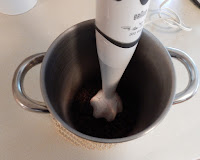Travel back back with me to the time our First Nation neighbors were called "Indians," not Native Americans or the more contemporary Indigenous Peoples. I was ten years old and going through a phase where I was enthralled by anything and everything "Indian."
As with most cases of juvenile fancy, mine was a romantic vision, the vision of James Fenimore Cooper's "The Nobel Savage." The old chiefs, Sitting Bull, Crazy Horse, Cochise and Joseph were my heroes. I read everything Indian I could, scavenged the riverbank on weekends for arrowheads, imitated Indian woodlore: fashioned a pipe bowl from clay (smoked Indian tobacco...sick for three days), foraged afield for camas root and coyote berries, munched on live grasshoppers (a nice crunch offset by a stomach-churning taste). Clad only in a homemade breechclout and moccasins made from a pair of Dad's discarded khaki pants, I romped about the neighborhood, scandalizing the neighbors.What most impressed me about Indians was their fierce independence on aboriginal survival skills, their hunting and foraging for sustenance in an oftentimes unforgiving natural world, the most challenging season of which was wintertime.
A principal staple for the "short, white days" was the Indian survival bar: pemmican. You didn't have to read far into a book about Indians before you happened upon a reference to the food. (Just the other day I read an excerpt from James Welch's Fools Crow, had scarcely read two pages when I came across the word used in the storyline not as sustenance for the living but for a child dead of smallpox about to begin its journey to the shadowlands.)
Pemmican: pimihkan, from the Cree dialect, is a natural food solely of Native American origin consisting of meat fiber and berries bound together with animal fat. Pemmican's appeal was twofold: its ingredients were readily available to North American Indians and the foodstuff, needing no preservatives or refrigeration, had a shelf life of years. The meat from buffalo, deer, elk, and bear provided the protein component of pemmican. Berries, harvested and dried from summer berry crops, flavored the meat ingredient. The jerky and berries were finely ground with mortar and pestle and the resulting compound bound together with molten animal fat, pounded flat, and then cut into strips to be stored for future consumption.
Perhaps it was a "second childhood" moment that piqued my interest in pemmican, but the truth of the matter was I saw a recipe for it on the internet, a "survivalists" website and thought with the holidays and winter approaching, "Why not make a batch?" The recipe called for only three ingredients...simple enough, (just like a P-B and J sandwich, right?): one cup each of dried meat, berries, and animal fat. Besides, with several gallons of summer blueberries in the freezer, I had one-third of the ingredients already covered.
As with most simple things like " three step instructions" or "just three ingredients," my pemmican experience became a week long adventure. I retrieved the dehydrator from its summer storage and put it to work drying a gallon bag of frozen blueberries. Three days it took to turn those plump morsels into desiccated kernels. I wanted my product to be as "Indian" as possible, so for the dried meat component I headed to Kelso's Custom Meats in Snohomish where I had seen buffalo meat for purchase. I knew I could count on Kelso's for my "animal fat" (suet) because they had provided that ingredient for my mincemeat recipe.
Once he learned what I was up to, Brian at Kelso's was eager to help. I told him I wanted to make the recipe in "the old way" if possible and did he have any buffalo meat? "Can't get it anymore," he said. "Deer or elk?" He couldn't help me there either. "Bear?"
(I was reaching now.) Brian smiled and shook his head. "Sorry."He then suggested lean beef, a cut popular for making jerky. Brian sliced two pounds of beef into quarter inch pieces. The suet was no problem. I headed home with two pounds of each to continue on down the pemmican trail.
I laid the thin beef slices on foil-lined baking sheets, preheated the oven to 180 degrees, and slid in the trays. Directions expressly warned against cooking the meat but drying it instead until the slices snapped or cracked; recipe said six to eight hours. It took seven hours for the meat to reach the "snap/crackle" stage. And I had to dry two batches.
Once again the "old ways" proved difficult. Our kitchen lacked a mortar and pestle for grinding the berries and meat. The wooden pestle used with the colander was no match for the dried blueberries. I might as well have been grinding gravel. Neither did the pestle work on the dried beef even though I first chopped it finely with a kitchen knife. To proceed, the "old ways" gave way to the "new ways." Even then I had to improvise as we had given away our food processor a few years back. A hand blender and a deep pot (for steaming asparagus) came to my rescue. Even on low speed, shards of blueberry and jerky shrapnel ricocheted from the pot (should have used protective eye wear). A towel wrapped around the blender corralled the contents until the berry/meat mixture was pulverized. A hot woodstove quickly rendered the suet into liquid.

The mound, which I molded into a half inch thick brick, quickly congealed rock solid. The next day I divided the brick into strips one inch wide and four inches long, wrapped two each in plastic wrap and then zip-loc bags for storage.
Print this post









That's an awful lot of work. I think I'll stick to my granola bars and hope for the best.
ReplyDeleteYeah, I'm thinking my time would have been better spent--and with more palatable results--if I'd made a batch of brownies instead. Thanks for reading The Ripple. TMJ
DeleteI have had pemmican before. I've never tried making it myself though.
ReplyDelete